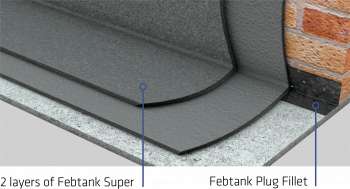
BASEMENT WATERPROOFING WITH FEBTANK SUPER WATERPROOF COATING
In recent time utilisation of previously unused basements and cellars has become a viable and economic alternative to home extensions or even moving home. However the ingress of water into basements continues to be the biggest barrier to the exploitation of these valuable and underutilised spaces.

The term ‘tanking’ is often used to describe the techniques and products used to remedy the problems of water ingress and whilst the methods of ‘tanking’ available are many and varied they all depend upon some basic principles.
Water is in many ways similar to a persistent burglar by taking the least line of resistance to gain entry to a property and when finding entry blocked, searches around to try to find another open window or door. Similarly water will gain access into a basement via the easiest route but if a waterproofing treatment is only added at the point where water is obviously penetrating the fabric of the building, then it will try to find another way into the structure, in many cases appearing metres away from the original wet area. This is why the true meaning of the term ‘tanking’ bears comparison to a fish tank in reverse, a fish tank keeps water in, tanking to a cellar keeps water out. Imagine a fish tank without one end, would it hold water? No! The same effect in reverse is often experienced when waterproofing a basement and a wall or floor have not been treated because ‘there was no sign of water in that area before we started’. So when assessing the extent of the waterproofing treatment needed try to think, where will the water go once you have blocked it? Obviously the most efficient and sure option is to create a ‘fully tanked’ environment.
With this in mind the Febtank Super tanking system provides both specialist applicators and builders with a simple brush applied waterproof tanking system for basements, inspection pits, ponds and water retaining structures. As with all surface applications preparation of substrates to receive the tanking system must be of the highest order as a tenacious bond is a prerequisite if the Febtank Super performs efficiently. So any paint or loose matter must be removed prior to installation, as this will inhibit the ability of the product to withstand the levels of water pressure regularly encountered.

Probably the most problematic areas for water ingress is the point where the wall meets the floor and it is this area that needs special attention by providing a ‘triangular fillet’ at the floor to wall intersection to help provide a seamless transition for the Febtank Super from floor to wall. Febtank Super comes in powder form and is mixed with water and applied to pre-dampened surfaces including brick, block-work, stone and concrete by stiff brush or broom. High-suction substrates require more dampening than dense substrates. However, make sure there is no freestanding water on floors. Any holes or voids should be repaired using mortar or Febtank Plug where ‘live’ water is leaking via the joint, hole or void to be repaired.
Febtank PlugThe first coat of Febtank Super should be firmly applied onto the pre-dampened, prepared surface. Care must be taken not to spread the material too thinly. To help ensure a total two coat coverage it is recommended that different colours of Febtank Super are used for the different coats normally grey for the first coat and white for the second. This provides a visual indication should total coverage with the second coat not be achieved.
Allow at least overnight to cure before applying subsequent coats. Dampen the first coat and remove excess moisture. If the application is in poorly ventilated rooms, condensation may occur on the first coat. This condensation should be removed from the surface. Apply the second coat at right angles to the first coat to ensure good covering.
Applications to floors should be protected with appropriate floor coverings or traditional screed. In most cases, render can be applied 24 hours after application of the Febtank Super. If application of finishing render is likely to be delayed for some time it is recommended that the Febtank Super is blinded with sand immediately after application to aid adhesion. If plaster is to be used it must be ensured that cement based ‘renovating plaster’ is used. N.B Gypsum based plasters must not be used.
If ‘Dry Lining’ is to be undertaken, boards should not be fixed using gypsum’ ‘dot and dab’ adhesive, Everbuild Dry Fix is recommended for this type of installation. Under no circumstances use mechanicals fixings that will penetrate the tanking. For installations involving ‘running’ water or severe hydrostatic pressure, refer to the Feb Technical Services for advice on specific application techniques.
Febtank Super is LABC registered and BBA approved so can be trusted by specialist applicators and builders as a high quality waterproofing solution which stands the test of time.